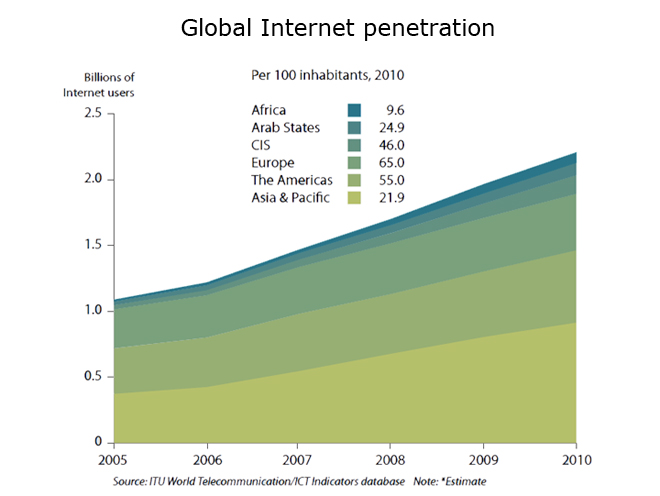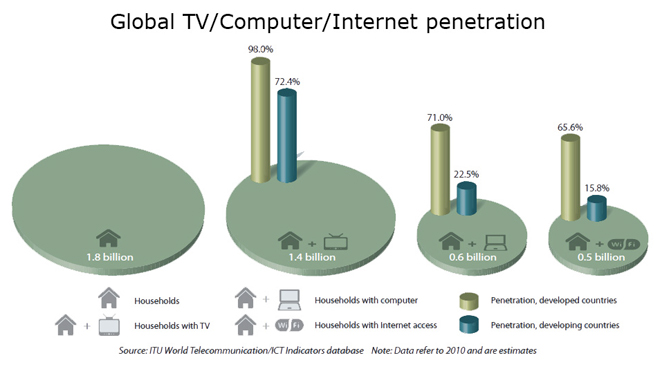Europe's online source of news, data & analysis for professionals involved in packaged media and new delivery technologies

ITU forecasts 2 billion people will be online by the end of 2010
The number of Internet users worldwide doubled in the past five years and will surpass the two billion mark in 2010, according to The International Telecommunication Union’s latest statistics published today in The World in 2010: ICT Facts and Figures. The number of people having access to the Internet at home has increased from 1.4 billion in 2009 to almost 1.6 billion in 2010.
As many as 162 million of the 226 million new Internet users in 2010 will be from developing countries, where Internet users grow at a higher rate. By the end of 2010, 71% of the population in developed countries will be online compared to 21% of the population in developing countries.
With more than 420 million Internet users, China is the largest Internet market in the world.
While in developed countries 65% of people have access to the Internet at home, this is the case for only 13.5% of people in developing countries where Internet access in schools, at work and public locations is critical. Regional differences are significant: 65% of Europeans are on the Internet, compared to only 9.6% of Africans.
While in developing countries 72.4% of households have a TV, only 22.5% have a computer and only 15.8% have Internet access (compared to 98%, 71% and 65.6% respectively in developed countries).

Over the past year, there has been strong growth in fixed broadband subscriptions. By the end of 2010, fixed broadband penetration will reach 555 million globally (or 8% penetration), up from 471 million (or 6.9% penetration) a year earlier. But penetration levels in developing countries remain low – 4.4 subscriptions per 100 people compared to 24.6 in developed countries.
While high-speed Internet is still out of reach for many people in low-income countries, mobile telephony is becoming ubiquitous, with access to mobile networks now available to over 90% of the global population. ITU’s new data indicate that among the estimated 5.3 billion mobile subscriptions by the end of 2010, 3.8 billion will be in the developing world. Mobile phone penetration in developing countries now stands at 68% – higher than any other technology before.

In developed countries, growth in mobile subscriptions has slowed considerably during the past five years, with a year-on-year growth from 2009-2010 of only 1.6%. In those countries, the mobile market is reaching saturation levels with on average 116 subscriptions per 100 inhabitants.
The trend from voice to (mobile) data applications is reflected in the growing number of SMS, or text messages sent, which tripled over the past three years to reach a staggering 6.1 trillion in 2010. In other words, close to 200,000 text messages are sent every second.
Overall, the price of ICT services is falling, but high-speed Internet access remains prohibitively expensive, especially in low-income developing countries. In 2009, an entry-level fixed (wired) broadband connection cost on average 190 PPP$ (Purchasing power parity in USD) per month in developing countries, compared to only 28 PPP$ in developed countries. Mobile cellular services are much more affordable, with an average monthly cost of 15 PPP$ in developing countries compared to around 18 PPP$ in developed countries.
The ITU is the United Nations’ agency for information and communication technologies.
Story filed 19.10.10




















